Why do we see swastika and pagan symbols in early churches?
0
votes
2
answers
230
views
Why do we see swastika in many early Christian churches? Swastika is considered pagan symbol bearing (prosperity and good luck). There are many pagan mosaics and other in Europe that have swastika, from the Romans, Greeks, Thracians etc. How was the pagan symbol adopted, and what does it mean in Christianity? Does any of the church fathers talk about that it is allowable to take pagan traditions / symbols and convert them to Christian with new meaning? I have heard that Basil the great has said something, but I don't know where to look to find what he have said.
There are many more churches with swastikas and other pagan symbols that where probably borrowed from the pagans.
 [Swastika (Wikipedia)](https://en.wikipedia.org/wiki/Swastika)
What does the catholic, orthodox and protestants say about this? Does anyone state that the apostles used these symbols, and learned the people to use them by oral tradition? And what is the reason, will we not look very similar to the pagans if we use their symbols. If the pagans served demons using these signs, where these signs not inspired by the demons that learned the people to serve them by using these signs?
How should this be understood?
Thanks in advance.
There seems to be a church or prayer hall dated 241AD where we can see swastika in it - Church at Megiddo
[Swastika (Wikipedia)](https://en.wikipedia.org/wiki/Swastika)
What does the catholic, orthodox and protestants say about this? Does anyone state that the apostles used these symbols, and learned the people to use them by oral tradition? And what is the reason, will we not look very similar to the pagans if we use their symbols. If the pagans served demons using these signs, where these signs not inspired by the demons that learned the people to serve them by using these signs?
How should this be understood?
Thanks in advance.
There seems to be a church or prayer hall dated 241AD where we can see swastika in it - Church at Megiddo
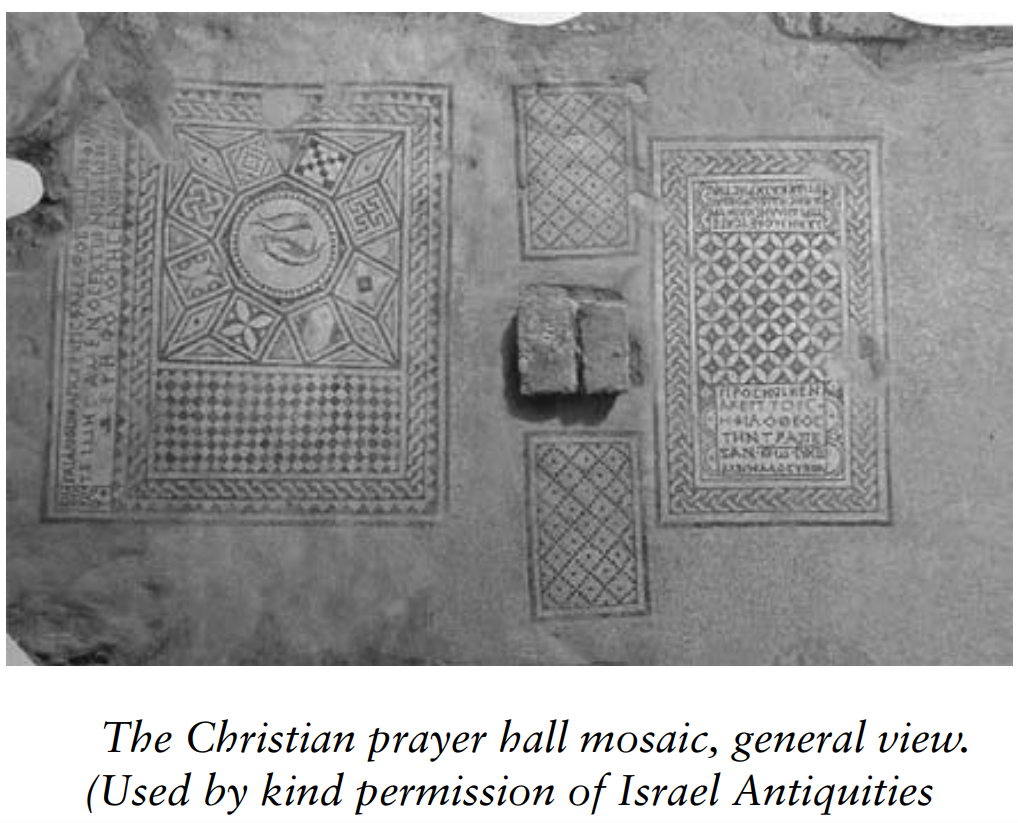 The Ancient Church at Megiddo
The Ancient Church at Megiddo
 The house was built around
231 ce and its adaptation for use as a church can be
securely dated to 240/241 ce. The Megiddo church
would be contemporaneous with this building.
Indeed, its construction, on the chronology suggested
by Tepper, would predate the Christianizing renovation at Dura Europos by about a decade. The
earliest Christian inscriptions that can be dated with
some level of confidence stem from the third century
ce and later.36 The floor inscriptions at Megiddo
would thus rank among the oldest epigraphic data
for Christianity.37 The Akeptous inscription would
probably offer the earliest epigraphic occurrence of
nomina sacra,38 and one of the earliest inscriptional
references to Jesus Christ.39 And the mosaic floor itself
would be a very rare instance of a pre-Constantinian
Christian mosaic.40
If dated towards the end of the third century ce
and especially after 313 ce, its significance would diminish, but it would still constitute valuable material evidence for ancient Christianity.
[The Ancient Church at Megiddo:
The Discovery and an Assessment of its Significance](https://2024.sci-hub.st/3600/018178562bf6388f4cfcc2ae31062ecb/adams2008.pdf)
The house was built around
231 ce and its adaptation for use as a church can be
securely dated to 240/241 ce. The Megiddo church
would be contemporaneous with this building.
Indeed, its construction, on the chronology suggested
by Tepper, would predate the Christianizing renovation at Dura Europos by about a decade. The
earliest Christian inscriptions that can be dated with
some level of confidence stem from the third century
ce and later.36 The floor inscriptions at Megiddo
would thus rank among the oldest epigraphic data
for Christianity.37 The Akeptous inscription would
probably offer the earliest epigraphic occurrence of
nomina sacra,38 and one of the earliest inscriptional
references to Jesus Christ.39 And the mosaic floor itself
would be a very rare instance of a pre-Constantinian
Christian mosaic.40
If dated towards the end of the third century ce
and especially after 313 ce, its significance would diminish, but it would still constitute valuable material evidence for ancient Christianity.
[The Ancient Church at Megiddo:
The Discovery and an Assessment of its Significance](https://2024.sci-hub.st/3600/018178562bf6388f4cfcc2ae31062ecb/adams2008.pdf)
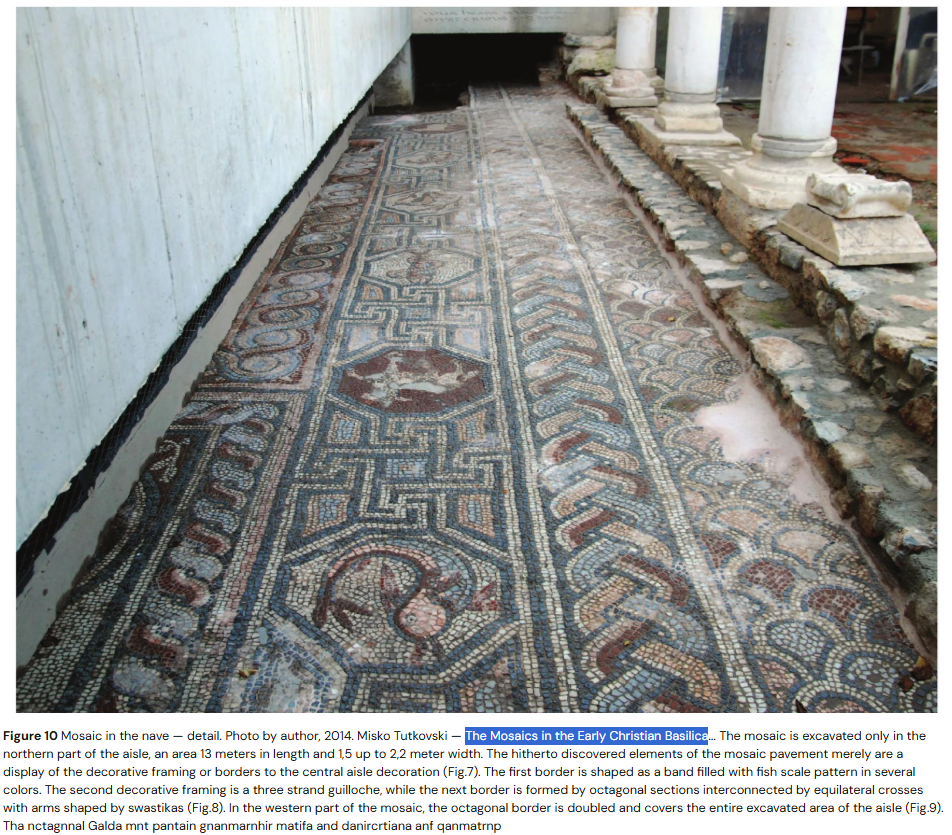
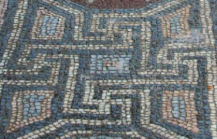 [he Mosaics in the Early Christian Basilica](https://www.academia.edu/figures/13123117/figure-10-mosaic-in-the-nave-detail-photo-by-author-misko)
[he Mosaics in the Early Christian Basilica](https://www.academia.edu/figures/13123117/figure-10-mosaic-in-the-nave-detail-photo-by-author-misko)
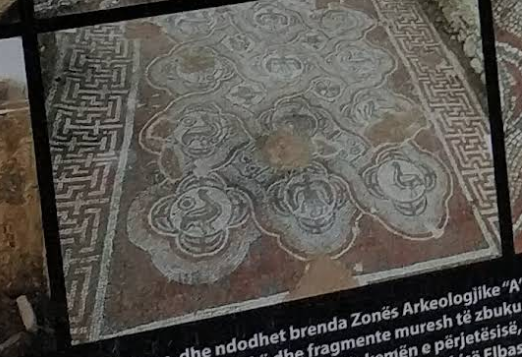
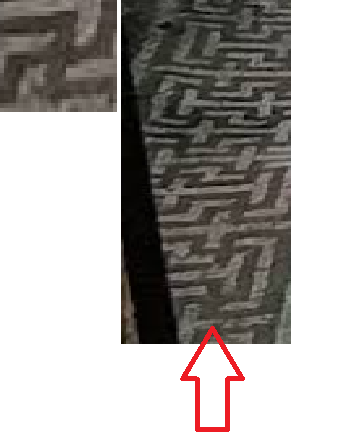 **5th c. AD**
[Basilica of Bezistan](https://www.google.com/maps/place/Basilica+of+Bezistan/@41.1115081,20.0820876,-7a,46.5y/data=!3m8!1e2!3m6!1sCIHM0ogKEICAgICM4v6MogE!2e10!3e12!6shttps:%2F%2Flh3.googleusercontent.com%2Fgps-cs-s%2FAC9h4nrNLmhkUvh19_R8pwBsGqVrvQAccAZkSIkUEcjuWQCHgxoki9La06ozGPuCEr9abeoLqcZKSQGP8PqO3lagdCqqwORVLMTcv75bK8DJn1JfMnjzhYKIPFIthuCkhBBe5TOeNh18qA%3Dw203-h151-k-no!7i4032!8i3016!4m11!1m2!2m1!1sPaleochristian+Basilica+!3m7!1s0x13504252132b80ff:0xf42f7dbed22221b2!8m2!3d41.1123356!4d20.0816528!10e5!15sChdQYWxlb2NocmlzdGlhbiBCYXNpbGljYVoZIhdwYWxlb2NocmlzdGlhbiBiYXNpbGljYZIBE2hpc3RvcmljYWxfbGFuZG1hcmuaASRDaGREU1VoTk1HOW5TMFZKUTBGblNVUjZlbEI2YUd0blJSQUKqAVwQASobIhdwYWxlb2NocmlzdGlhbiBiYXNpbGljYSgAMh4QASIa-Ru4kMrII6__LK6712EEuiYlpxWUOYQE-W8yGxACIhdwYWxlb2NocmlzdGlhbiBiYXNpbGljYeABAPoBBAgSEBk!16s%2Fg%2F11glw_f49c?entry=ttu&g_ep=EgoyMDI1MDkxNy4wIKXMDSoASAFQAw%3D%3D)
**5th c. AD**
[Basilica of Bezistan](https://www.google.com/maps/place/Basilica+of+Bezistan/@41.1115081,20.0820876,-7a,46.5y/data=!3m8!1e2!3m6!1sCIHM0ogKEICAgICM4v6MogE!2e10!3e12!6shttps:%2F%2Flh3.googleusercontent.com%2Fgps-cs-s%2FAC9h4nrNLmhkUvh19_R8pwBsGqVrvQAccAZkSIkUEcjuWQCHgxoki9La06ozGPuCEr9abeoLqcZKSQGP8PqO3lagdCqqwORVLMTcv75bK8DJn1JfMnjzhYKIPFIthuCkhBBe5TOeNh18qA%3Dw203-h151-k-no!7i4032!8i3016!4m11!1m2!2m1!1sPaleochristian+Basilica+!3m7!1s0x13504252132b80ff:0xf42f7dbed22221b2!8m2!3d41.1123356!4d20.0816528!10e5!15sChdQYWxlb2NocmlzdGlhbiBCYXNpbGljYVoZIhdwYWxlb2NocmlzdGlhbiBiYXNpbGljYZIBE2hpc3RvcmljYWxfbGFuZG1hcmuaASRDaGREU1VoTk1HOW5TMFZKUTBGblNVUjZlbEI2YUd0blJSQUKqAVwQASobIhdwYWxlb2NocmlzdGlhbiBiYXNpbGljYSgAMh4QASIa-Ru4kMrII6__LK6712EEuiYlpxWUOYQE-W8yGxACIhdwYWxlb2NocmlzdGlhbiBiYXNpbGljYeABAPoBBAgSEBk!16s%2Fg%2F11glw_f49c?entry=ttu&g_ep=EgoyMDI1MDkxNy4wIKXMDSoASAFQAw%3D%3D)
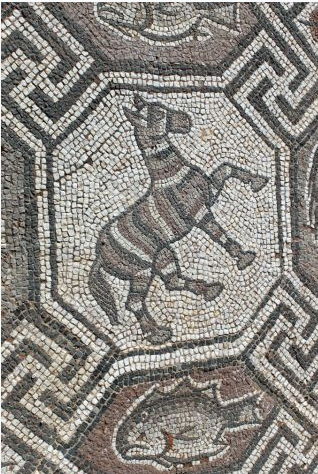 Early Christian Basilica church at Delphi
The foundations and the mosaics of the narthex and the aisles of a late 5th – early 6th c. AD Christian Basilica were found in the place now occupied by “Apollo Hotel”.
https://thedelphiguide.com/early-christian-basilica-church-at-delphi/
Early Christian Basilica church at Delphi
The foundations and the mosaics of the narthex and the aisles of a late 5th – early 6th c. AD Christian Basilica were found in the place now occupied by “Apollo Hotel”.
https://thedelphiguide.com/early-christian-basilica-church-at-delphi/
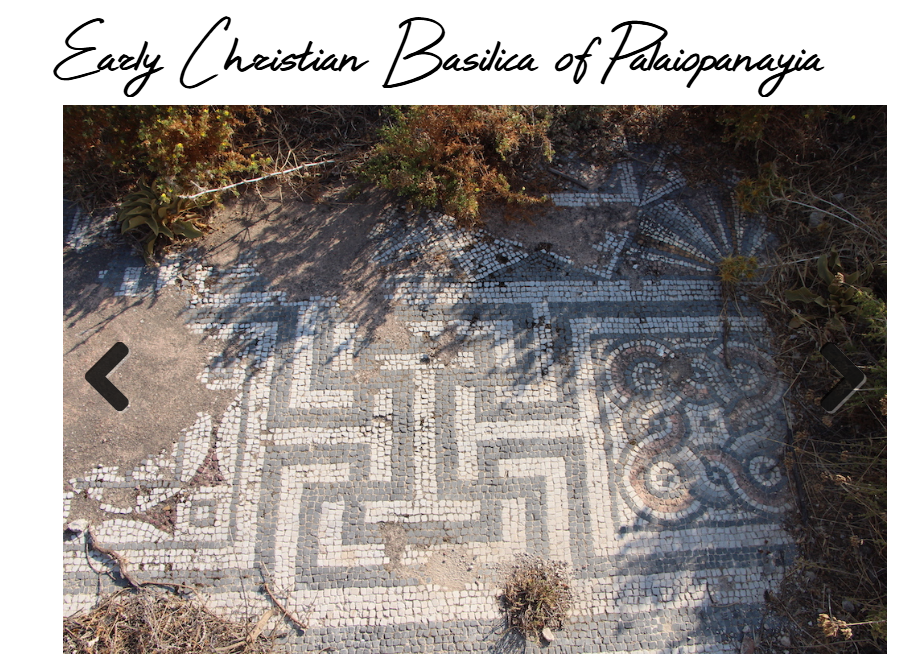 https://www.discoveringkos.com/destination-item/early-christian-basilica-of-palaiopanayia/
https://www.discoveringkos.com/destination-item/early-christian-basilica-of-palaiopanayia/
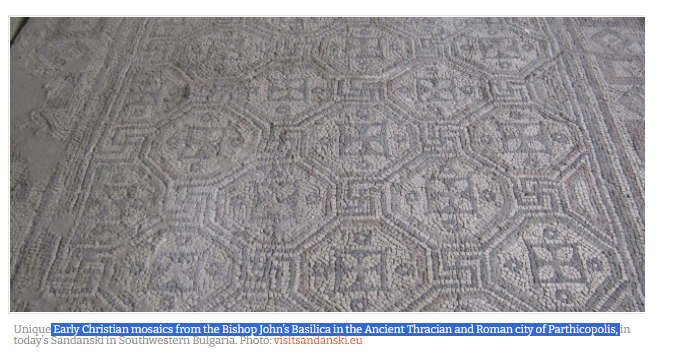 https://archaeologyinbulgaria.wordpress.com/2015/04/02/archaeologists-discover-hand-from-huge-roman-statue-at-early-christian-site-in-bulgarias-sandanski/#:~:text=The%20Bishop%27s%20Basilica%20is%20the,Operational%20Program%20%E2%80%9CRegional%20Development%E2%80%9D
https://archaeologyinbulgaria.wordpress.com/2015/04/02/archaeologists-discover-hand-from-huge-roman-statue-at-early-christian-site-in-bulgarias-sandanski/#:~:text=The%20Bishop%27s%20Basilica%20is%20the,Operational%20Program%20%E2%80%9CRegional%20Development%E2%80%9D
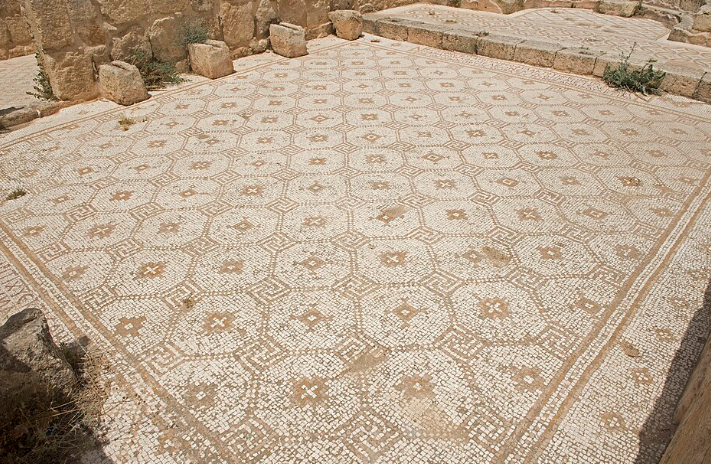 Jerash Church of Marianos - built in 570 AD under the episcopate of Bishop Marianos
Jerash Church of Marianos - built in 570 AD under the episcopate of Bishop Marianos
 =========================================================
In pagan cultures:
Some statements by some sites. The information needs to be checked.
The association of the swastika with deities is certainly seen during the Geometric and Orientalising periods. In the Geometric period, we certainly have evidence for the existence of the Olympian Pantheon, ranging from shrines to Zeus, Apollo, Demeter, Hera and Artemis (Coldstream 2003: 327-332). However in the Geometric period we find that the swastika can be found, especially, with images of Artemis.....but it also gives us proof in the it being used in association with deities,.....Now Artemis is not the only goddess we see associated with the swastika, in this example we see it associated with, what one might presume, to be Demeter....We have seen it being used in association with deities, animals, mythology and people
=========================================================
In pagan cultures:
Some statements by some sites. The information needs to be checked.
The association of the swastika with deities is certainly seen during the Geometric and Orientalising periods. In the Geometric period, we certainly have evidence for the existence of the Olympian Pantheon, ranging from shrines to Zeus, Apollo, Demeter, Hera and Artemis (Coldstream 2003: 327-332). However in the Geometric period we find that the swastika can be found, especially, with images of Artemis.....but it also gives us proof in the it being used in association with deities,.....Now Artemis is not the only goddess we see associated with the swastika, in this example we see it associated with, what one might presume, to be Demeter....We have seen it being used in association with deities, animals, mythology and people
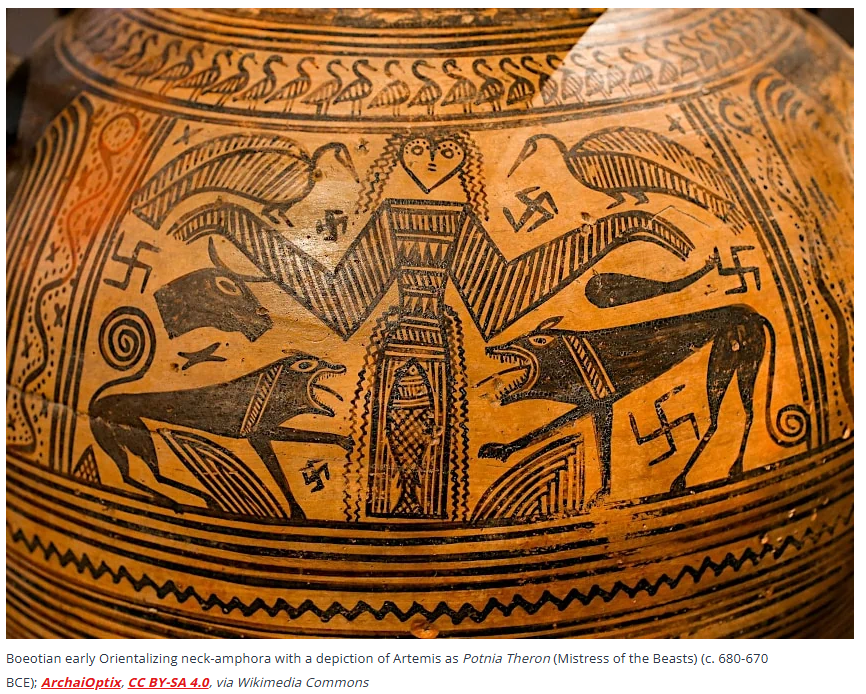 https://learning-history.com/greek-goddess-artemis/
https://www.greecehighdefinition.com/blog/2019/1/22/ancient-greek-origins-of-the-swastika-in-archaic-greece
https://learning-history.com/greek-goddess-artemis/
https://www.greecehighdefinition.com/blog/2019/1/22/ancient-greek-origins-of-the-swastika-in-archaic-greece
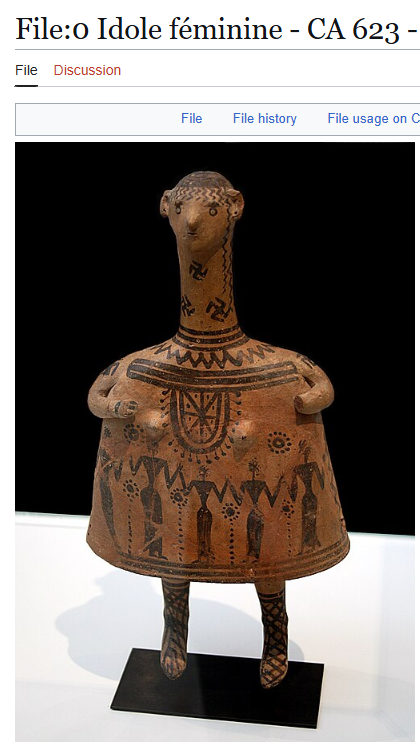
.JPG) This person in the video also says that the swastika is associated with the sun and idols calling them "the gods", luck, victory etc. It does not seem to be just decoration without meaning.
https://www.youtube.com/watch?v=PnsEBTL5mZc
How accurate is all this I can not verify.
.....................................................
This person in the video also says that the swastika is associated with the sun and idols calling them "the gods", luck, victory etc. It does not seem to be just decoration without meaning.
https://www.youtube.com/watch?v=PnsEBTL5mZc
How accurate is all this I can not verify.
.....................................................
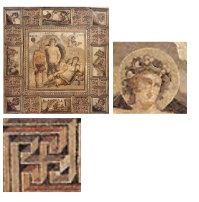 Floor Mosaic Depicting Dionysos's Discovery of Ariadne on Naxos
Roman, probably from Syria
Roman
3rd to 4th centuries
Stone tesserae in mortar
https://www.miho.jp/booth/html/artcon/00001755e.htm
Floor Mosaic Depicting Dionysos's Discovery of Ariadne on Naxos
Roman, probably from Syria
Roman
3rd to 4th centuries
Stone tesserae in mortar
https://www.miho.jp/booth/html/artcon/00001755e.htm
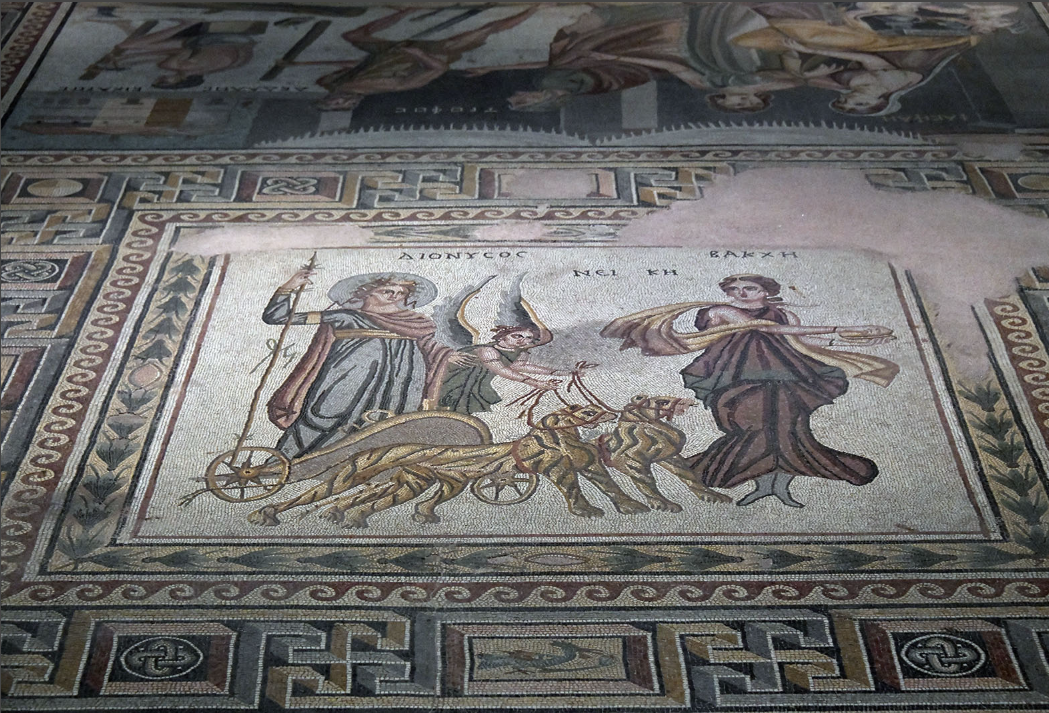 https://pbase.com/dosseman/dionysostriumf
(2nd c. AD) Dionysos, Nike & Maenad (Bakche) - Zeugma mosaic -
Triumph of Dionysus
(Gaziantep Museum - Turkey) This pavement comes from the House of Poseidon.
1.https://www.flickr.com/photos/28433765@N07/50616496196
2.https://pbase.com/dosseman/dionysostriumf
3.https://pbase.com/dosseman/image/170042225
4.https://pbase.com/dosseman/daedalus
https://pbase.com/dosseman/dionysostriumf
(2nd c. AD) Dionysos, Nike & Maenad (Bakche) - Zeugma mosaic -
Triumph of Dionysus
(Gaziantep Museum - Turkey) This pavement comes from the House of Poseidon.
1.https://www.flickr.com/photos/28433765@N07/50616496196
2.https://pbase.com/dosseman/dionysostriumf
3.https://pbase.com/dosseman/image/170042225
4.https://pbase.com/dosseman/daedalus
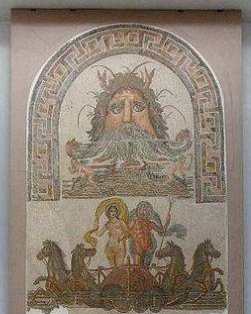 https://assaffeller.com/%D7%9E%D7%99%D7%AA%D7%95%D7%9C%D7%95%D7%92%D7%99%D7%94/%D7%A4%D7%A1%D7%99%D7%A4%D7%A1%D7%99-%D7%AA%D7%95%D7%A0%D7%99%D7%A1-%D7%9E%D7%95%D7%96%D7%99%D7%90%D7%95%D7%9F-%D7%91%D7%90%D7%A8%D7%93%D7%95
https://assaffeller.com/%D7%9E%D7%99%D7%AA%D7%95%D7%9C%D7%95%D7%92%D7%99%D7%94/%D7%A4%D7%A1%D7%99%D7%A4%D7%A1%D7%99-%D7%AA%D7%95%D7%A0%D7%99%D7%A1-%D7%9E%D7%95%D7%96%D7%99%D7%90%D7%95%D7%9F-%D7%91%D7%90%D7%A8%D7%93%D7%95
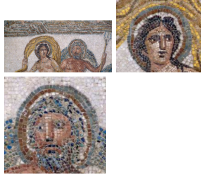
 Triumph of Neptune and Amphitrite, mosaic from Utica, Tunisia, Roman civilization, 3rd-4th century AD, Detail
https://www.bridgemanimages.com/en/noartistknown/triumph-of-neptune-and-amphitrite-mosaic-from-utica-tunisia-roman-civilization-3rd-4th-century-ad/nomedium/asset/2569228
https://assaffeller.com/%D7%9E%D7%99%D7%AA%D7%95%D7%9C%D7%95%D7%92%D7%99%D7%94/%D7%A4%D7%A1%D7%99%D7%A4%D7%A1%D7%99-%D7%AA%D7%95%D7%A0%D7%99%D7%A1-%D7%9E%D7%95%D7%96%D7%99%D7%90%D7%95%D7%9F-%D7%91%D7%90%D7%A8%D7%93%D7%95
Swastika and halo in the pagan culture - also found in the Christian iconography in later time some sources say - 4 th c. AD - catacombs of Commodilla is one of the first images of Christ with a halo around his head.
Triumph of Neptune and Amphitrite, mosaic from Utica, Tunisia, Roman civilization, 3rd-4th century AD, Detail
https://www.bridgemanimages.com/en/noartistknown/triumph-of-neptune-and-amphitrite-mosaic-from-utica-tunisia-roman-civilization-3rd-4th-century-ad/nomedium/asset/2569228
https://assaffeller.com/%D7%9E%D7%99%D7%AA%D7%95%D7%9C%D7%95%D7%92%D7%99%D7%94/%D7%A4%D7%A1%D7%99%D7%A4%D7%A1%D7%99-%D7%AA%D7%95%D7%A0%D7%99%D7%A1-%D7%9E%D7%95%D7%96%D7%99%D7%90%D7%95%D7%9F-%D7%91%D7%90%D7%A8%D7%93%D7%95
Swastika and halo in the pagan culture - also found in the Christian iconography in later time some sources say - 4 th c. AD - catacombs of Commodilla is one of the first images of Christ with a halo around his head.
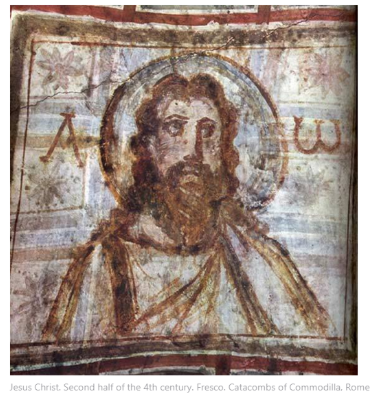 This is just to show that there seems to be adoption of pagan elements in later Christianity.
-------------------------------------------------------------
ENGLISH
T**he ancient Christian Church adopted the Greek "gamma cross," giving it the meaning of salvation.** The swastika is found in paintings of early Christian catacombs, on medieval tombstones, and on priestly vestments of the 12th-14th centuries.
This is just to show that there seems to be adoption of pagan elements in later Christianity.
-------------------------------------------------------------
ENGLISH
T**he ancient Christian Church adopted the Greek "gamma cross," giving it the meaning of salvation.** The swastika is found in paintings of early Christian catacombs, on medieval tombstones, and on priestly vestments of the 12th-14th centuries. The swastika is present in the mosaic covering the floor of the Basilica of the Nativity in Bethlehem. It is depicted among fragments of the oldest mosaic floor, preserved from the original basilica from the time of Emperor Constantine the Great and his mother Helena (the church was founded in the 320s by order of Emperor Constantine). Inside the swastika is a square, in the center of which is an inscription: Greek ΪΧΘΥΣ - "fish", this word was used in early Christian symbolism as an abbreviation: "Jesus Christ, Son of God, Savior."
https://ru.wikipedia.org/wiki/%D0%A1%D0%B2%D0%B0%D1%81%D1%82%D0%B8%D0%BA%D0%B0#%D0%A5%D1%80%D0%B8%D1%81%D1%82%D0%B8%D0%B0%D0%BD%D1%81%D1%82%D0%B2%D0%BE
The swastika is present in the mosaic covering the floor of the Basilica of the Nativity in Bethlehem. It is depicted among fragments of the oldest mosaic floor, preserved from the original basilica from the time of Emperor Constantine the Great and his mother Helena (the church was founded in the 320s by order of Emperor Constantine). Inside the swastika is a square, in the center of which is an inscription: Greek ΪΧΘΥΣ - "fish", this word was used in early Christian symbolism as an abbreviation: "Jesus Christ, Son of God, Savior."
https://ru.wikipedia.org/wiki/%D0%A1%D0%B2%D0%B0%D1%81%D1%82%D0%B8%D0%BA%D0%B0#%D0%A5%D1%80%D0%B8%D1%81%D1%82%D0%B8%D0%B0%D0%BD%D1%81%D1%82%D0%B2%D0%BE
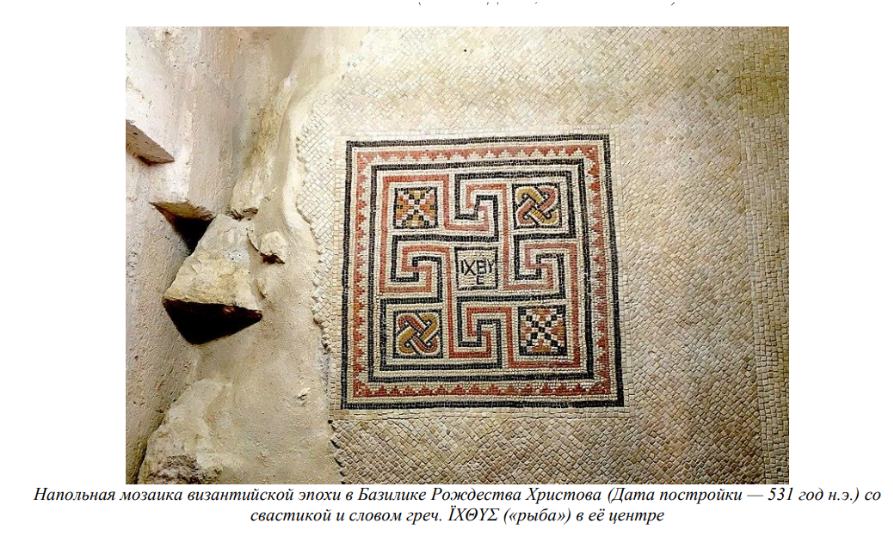 Basilica of the Nativity, Bethlehem, Palestine, 4th century. The 4th-century floor mosaics.
https://ru.pinterest.com/pin/223843043964727318/
https://ru.wikipedia.org/wiki/%D0%A1%D0%B2%D0%B0%D1%81%D1%82%D0%B8%D0%BA%D0%B0#%D0%A5%D1%80%D0%B8%D1%81%D1%82%D0%B8%D0%B0%D0%BD%D1%81%D1%82%D0%B2%D0%BE
https://vp-sssr.ru/download/works/35/k-voprosu-o-zaprete-ekstremistskoi-simvoliki.pdf
Basilica of the Nativity, Bethlehem, Palestine, 4th century. The 4th-century floor mosaics.
https://ru.pinterest.com/pin/223843043964727318/
https://ru.wikipedia.org/wiki/%D0%A1%D0%B2%D0%B0%D1%81%D1%82%D0%B8%D0%BA%D0%B0#%D0%A5%D1%80%D0%B8%D1%81%D1%82%D0%B8%D0%B0%D0%BD%D1%81%D1%82%D0%B2%D0%BE
https://vp-sssr.ru/download/works/35/k-voprosu-o-zaprete-ekstremistskoi-simvoliki.pdf
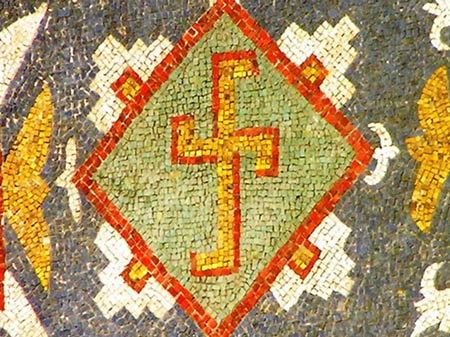
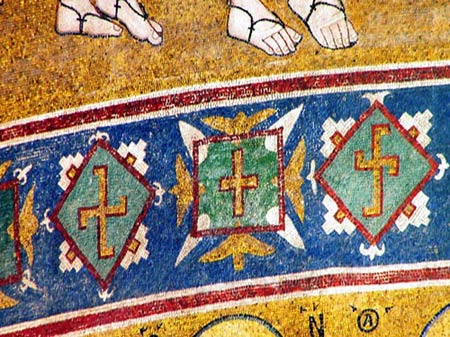 Saint Sophia Cathedral in Kyiv. Altar mosaic
https://tehlib.com/arhitektura/sofijskij-sobor-v-kieve/
Crux Gammata. Mosaic of the Saint Sophia Cathedral of Kiev, 11th century AD.
https://irenecaesar.wordpress.com/tag/%D1%81%D0%B2%D0%B0%D1%81%D1%82%D0%B8%D0%BA%D0%B0-%D0%B2-%D0%B2%D0%B8%D0%B7%D0%B0%D0%BD%D1%82%D0%B8%D0%B8/
Saint Sophia Cathedral in Kyiv. Altar mosaic
https://tehlib.com/arhitektura/sofijskij-sobor-v-kieve/
Crux Gammata. Mosaic of the Saint Sophia Cathedral of Kiev, 11th century AD.
https://irenecaesar.wordpress.com/tag/%D1%81%D0%B2%D0%B0%D1%81%D1%82%D0%B8%D0%BA%D0%B0-%D0%B2-%D0%B2%D0%B8%D0%B7%D0%B0%D0%BD%D1%82%D0%B8%D0%B8/
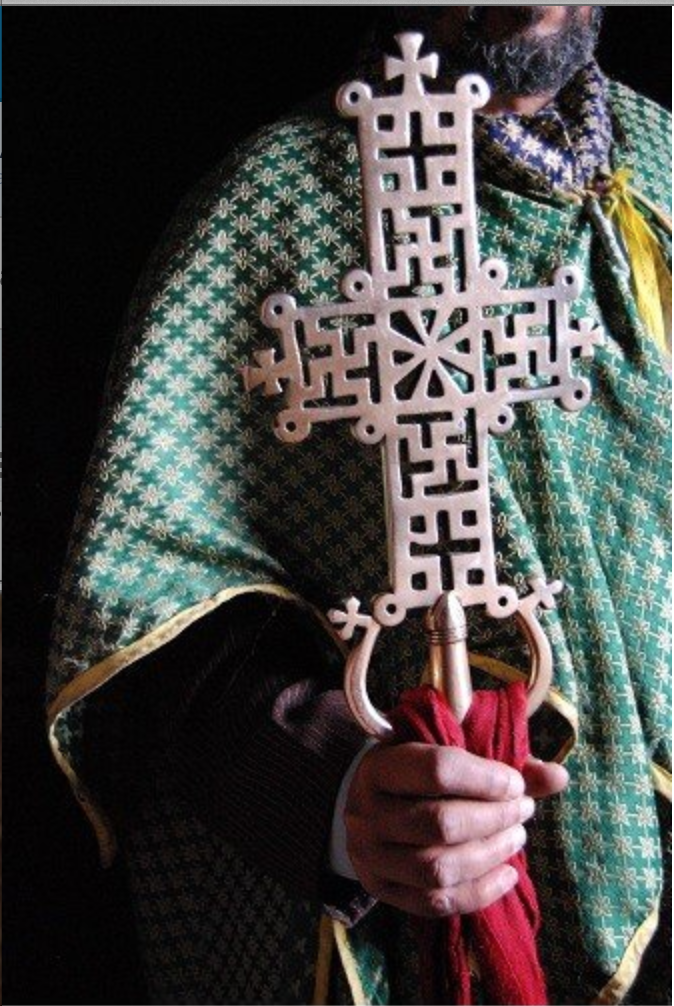 Lalibela, Ethiopia, with a Cross, which consists of the multiplied Gammadion / Gammadia.
[The Crux Gammata is the Tetragrammaton](https://irenecaesar.wordpress.com/tag/%D1%81%D0%B2%D0%B0%D1%81%D1%82%D0%B8%D0%BA%D0%B0-%D0%B2-%D0%B2%D0%B8%D0%B7%D0%B0%D0%BD%D1%82%D0%B8%D0%B8/)
The links are shared only because of the images as sources.
I don't guarantee the accurateness of the information.
This is just what I see on the interned and it seems that swastika is even used on processional crosses. There can be also seen a Latin cross in the form of swastika the sources say 11 c. AD. It seems that there is some meaning in the swastika it is not just an ornament from this what I see if the information is correct.
Also ΪΧΘΥΣ in the center of the swastika.
Lalibela, Ethiopia, with a Cross, which consists of the multiplied Gammadion / Gammadia.
[The Crux Gammata is the Tetragrammaton](https://irenecaesar.wordpress.com/tag/%D1%81%D0%B2%D0%B0%D1%81%D1%82%D0%B8%D0%BA%D0%B0-%D0%B2-%D0%B2%D0%B8%D0%B7%D0%B0%D0%BD%D1%82%D0%B8%D0%B8/)
The links are shared only because of the images as sources.
I don't guarantee the accurateness of the information.
This is just what I see on the interned and it seems that swastika is even used on processional crosses. There can be also seen a Latin cross in the form of swastika the sources say 11 c. AD. It seems that there is some meaning in the swastika it is not just an ornament from this what I see if the information is correct.
Also ΪΧΘΥΣ in the center of the swastika.
 [Swastika (Wikipedia)](https://en.wikipedia.org/wiki/Swastika)
What does the catholic, orthodox and protestants say about this? Does anyone state that the apostles used these symbols, and learned the people to use them by oral tradition? And what is the reason, will we not look very similar to the pagans if we use their symbols. If the pagans served demons using these signs, where these signs not inspired by the demons that learned the people to serve them by using these signs?
How should this be understood?
Thanks in advance.
There seems to be a church or prayer hall dated 241AD where we can see swastika in it - Church at Megiddo
[Swastika (Wikipedia)](https://en.wikipedia.org/wiki/Swastika)
What does the catholic, orthodox and protestants say about this? Does anyone state that the apostles used these symbols, and learned the people to use them by oral tradition? And what is the reason, will we not look very similar to the pagans if we use their symbols. If the pagans served demons using these signs, where these signs not inspired by the demons that learned the people to serve them by using these signs?
How should this be understood?
Thanks in advance.
There seems to be a church or prayer hall dated 241AD where we can see swastika in it - Church at Megiddo
 The Ancient Church at Megiddo
The Ancient Church at Megiddo
 The house was built around
231 ce and its adaptation for use as a church can be
securely dated to 240/241 ce. The Megiddo church
would be contemporaneous with this building.
Indeed, its construction, on the chronology suggested
by Tepper, would predate the Christianizing renovation at Dura Europos by about a decade. The
earliest Christian inscriptions that can be dated with
some level of confidence stem from the third century
ce and later.36 The floor inscriptions at Megiddo
would thus rank among the oldest epigraphic data
for Christianity.37 The Akeptous inscription would
probably offer the earliest epigraphic occurrence of
nomina sacra,38 and one of the earliest inscriptional
references to Jesus Christ.39 And the mosaic floor itself
would be a very rare instance of a pre-Constantinian
Christian mosaic.40
If dated towards the end of the third century ce
and especially after 313 ce, its significance would diminish, but it would still constitute valuable material evidence for ancient Christianity.
[The Ancient Church at Megiddo:
The Discovery and an Assessment of its Significance](https://2024.sci-hub.st/3600/018178562bf6388f4cfcc2ae31062ecb/adams2008.pdf)
The house was built around
231 ce and its adaptation for use as a church can be
securely dated to 240/241 ce. The Megiddo church
would be contemporaneous with this building.
Indeed, its construction, on the chronology suggested
by Tepper, would predate the Christianizing renovation at Dura Europos by about a decade. The
earliest Christian inscriptions that can be dated with
some level of confidence stem from the third century
ce and later.36 The floor inscriptions at Megiddo
would thus rank among the oldest epigraphic data
for Christianity.37 The Akeptous inscription would
probably offer the earliest epigraphic occurrence of
nomina sacra,38 and one of the earliest inscriptional
references to Jesus Christ.39 And the mosaic floor itself
would be a very rare instance of a pre-Constantinian
Christian mosaic.40
If dated towards the end of the third century ce
and especially after 313 ce, its significance would diminish, but it would still constitute valuable material evidence for ancient Christianity.
[The Ancient Church at Megiddo:
The Discovery and an Assessment of its Significance](https://2024.sci-hub.st/3600/018178562bf6388f4cfcc2ae31062ecb/adams2008.pdf)

 [he Mosaics in the Early Christian Basilica](https://www.academia.edu/figures/13123117/figure-10-mosaic-in-the-nave-detail-photo-by-author-misko)
[he Mosaics in the Early Christian Basilica](https://www.academia.edu/figures/13123117/figure-10-mosaic-in-the-nave-detail-photo-by-author-misko)

 **5th c. AD**
[Basilica of Bezistan](https://www.google.com/maps/place/Basilica+of+Bezistan/@41.1115081,20.0820876,-7a,46.5y/data=!3m8!1e2!3m6!1sCIHM0ogKEICAgICM4v6MogE!2e10!3e12!6shttps:%2F%2Flh3.googleusercontent.com%2Fgps-cs-s%2FAC9h4nrNLmhkUvh19_R8pwBsGqVrvQAccAZkSIkUEcjuWQCHgxoki9La06ozGPuCEr9abeoLqcZKSQGP8PqO3lagdCqqwORVLMTcv75bK8DJn1JfMnjzhYKIPFIthuCkhBBe5TOeNh18qA%3Dw203-h151-k-no!7i4032!8i3016!4m11!1m2!2m1!1sPaleochristian+Basilica+!3m7!1s0x13504252132b80ff:0xf42f7dbed22221b2!8m2!3d41.1123356!4d20.0816528!10e5!15sChdQYWxlb2NocmlzdGlhbiBCYXNpbGljYVoZIhdwYWxlb2NocmlzdGlhbiBiYXNpbGljYZIBE2hpc3RvcmljYWxfbGFuZG1hcmuaASRDaGREU1VoTk1HOW5TMFZKUTBGblNVUjZlbEI2YUd0blJSQUKqAVwQASobIhdwYWxlb2NocmlzdGlhbiBiYXNpbGljYSgAMh4QASIa-Ru4kMrII6__LK6712EEuiYlpxWUOYQE-W8yGxACIhdwYWxlb2NocmlzdGlhbiBiYXNpbGljYeABAPoBBAgSEBk!16s%2Fg%2F11glw_f49c?entry=ttu&g_ep=EgoyMDI1MDkxNy4wIKXMDSoASAFQAw%3D%3D)
**5th c. AD**
[Basilica of Bezistan](https://www.google.com/maps/place/Basilica+of+Bezistan/@41.1115081,20.0820876,-7a,46.5y/data=!3m8!1e2!3m6!1sCIHM0ogKEICAgICM4v6MogE!2e10!3e12!6shttps:%2F%2Flh3.googleusercontent.com%2Fgps-cs-s%2FAC9h4nrNLmhkUvh19_R8pwBsGqVrvQAccAZkSIkUEcjuWQCHgxoki9La06ozGPuCEr9abeoLqcZKSQGP8PqO3lagdCqqwORVLMTcv75bK8DJn1JfMnjzhYKIPFIthuCkhBBe5TOeNh18qA%3Dw203-h151-k-no!7i4032!8i3016!4m11!1m2!2m1!1sPaleochristian+Basilica+!3m7!1s0x13504252132b80ff:0xf42f7dbed22221b2!8m2!3d41.1123356!4d20.0816528!10e5!15sChdQYWxlb2NocmlzdGlhbiBCYXNpbGljYVoZIhdwYWxlb2NocmlzdGlhbiBiYXNpbGljYZIBE2hpc3RvcmljYWxfbGFuZG1hcmuaASRDaGREU1VoTk1HOW5TMFZKUTBGblNVUjZlbEI2YUd0blJSQUKqAVwQASobIhdwYWxlb2NocmlzdGlhbiBiYXNpbGljYSgAMh4QASIa-Ru4kMrII6__LK6712EEuiYlpxWUOYQE-W8yGxACIhdwYWxlb2NocmlzdGlhbiBiYXNpbGljYeABAPoBBAgSEBk!16s%2Fg%2F11glw_f49c?entry=ttu&g_ep=EgoyMDI1MDkxNy4wIKXMDSoASAFQAw%3D%3D)
 Early Christian Basilica church at Delphi
The foundations and the mosaics of the narthex and the aisles of a late 5th – early 6th c. AD Christian Basilica were found in the place now occupied by “Apollo Hotel”.
https://thedelphiguide.com/early-christian-basilica-church-at-delphi/
Early Christian Basilica church at Delphi
The foundations and the mosaics of the narthex and the aisles of a late 5th – early 6th c. AD Christian Basilica were found in the place now occupied by “Apollo Hotel”.
https://thedelphiguide.com/early-christian-basilica-church-at-delphi/
 https://www.discoveringkos.com/destination-item/early-christian-basilica-of-palaiopanayia/
https://www.discoveringkos.com/destination-item/early-christian-basilica-of-palaiopanayia/
 https://archaeologyinbulgaria.wordpress.com/2015/04/02/archaeologists-discover-hand-from-huge-roman-statue-at-early-christian-site-in-bulgarias-sandanski/#:~:text=The%20Bishop%27s%20Basilica%20is%20the,Operational%20Program%20%E2%80%9CRegional%20Development%E2%80%9D
https://archaeologyinbulgaria.wordpress.com/2015/04/02/archaeologists-discover-hand-from-huge-roman-statue-at-early-christian-site-in-bulgarias-sandanski/#:~:text=The%20Bishop%27s%20Basilica%20is%20the,Operational%20Program%20%E2%80%9CRegional%20Development%E2%80%9D
 Jerash Church of Marianos - built in 570 AD under the episcopate of Bishop Marianos
Jerash Church of Marianos - built in 570 AD under the episcopate of Bishop Marianos
 =========================================================
In pagan cultures:
Some statements by some sites. The information needs to be checked.
The association of the swastika with deities is certainly seen during the Geometric and Orientalising periods. In the Geometric period, we certainly have evidence for the existence of the Olympian Pantheon, ranging from shrines to Zeus, Apollo, Demeter, Hera and Artemis (Coldstream 2003: 327-332). However in the Geometric period we find that the swastika can be found, especially, with images of Artemis.....but it also gives us proof in the it being used in association with deities,.....Now Artemis is not the only goddess we see associated with the swastika, in this example we see it associated with, what one might presume, to be Demeter....We have seen it being used in association with deities, animals, mythology and people
=========================================================
In pagan cultures:
Some statements by some sites. The information needs to be checked.
The association of the swastika with deities is certainly seen during the Geometric and Orientalising periods. In the Geometric period, we certainly have evidence for the existence of the Olympian Pantheon, ranging from shrines to Zeus, Apollo, Demeter, Hera and Artemis (Coldstream 2003: 327-332). However in the Geometric period we find that the swastika can be found, especially, with images of Artemis.....but it also gives us proof in the it being used in association with deities,.....Now Artemis is not the only goddess we see associated with the swastika, in this example we see it associated with, what one might presume, to be Demeter....We have seen it being used in association with deities, animals, mythology and people
 https://learning-history.com/greek-goddess-artemis/
https://www.greecehighdefinition.com/blog/2019/1/22/ancient-greek-origins-of-the-swastika-in-archaic-greece
https://learning-history.com/greek-goddess-artemis/
https://www.greecehighdefinition.com/blog/2019/1/22/ancient-greek-origins-of-the-swastika-in-archaic-greece

 Floor Mosaic Depicting Dionysos's Discovery of Ariadne on Naxos
Roman, probably from Syria
Roman
3rd to 4th centuries
Stone tesserae in mortar
https://www.miho.jp/booth/html/artcon/00001755e.htm
Floor Mosaic Depicting Dionysos's Discovery of Ariadne on Naxos
Roman, probably from Syria
Roman
3rd to 4th centuries
Stone tesserae in mortar
https://www.miho.jp/booth/html/artcon/00001755e.htm
 https://pbase.com/dosseman/dionysostriumf
(2nd c. AD) Dionysos, Nike & Maenad (Bakche) - Zeugma mosaic -
Triumph of Dionysus
(Gaziantep Museum - Turkey) This pavement comes from the House of Poseidon.
1.https://www.flickr.com/photos/28433765@N07/50616496196
2.https://pbase.com/dosseman/dionysostriumf
3.https://pbase.com/dosseman/image/170042225
4.https://pbase.com/dosseman/daedalus
https://pbase.com/dosseman/dionysostriumf
(2nd c. AD) Dionysos, Nike & Maenad (Bakche) - Zeugma mosaic -
Triumph of Dionysus
(Gaziantep Museum - Turkey) This pavement comes from the House of Poseidon.
1.https://www.flickr.com/photos/28433765@N07/50616496196
2.https://pbase.com/dosseman/dionysostriumf
3.https://pbase.com/dosseman/image/170042225
4.https://pbase.com/dosseman/daedalus
 https://assaffeller.com/%D7%9E%D7%99%D7%AA%D7%95%D7%9C%D7%95%D7%92%D7%99%D7%94/%D7%A4%D7%A1%D7%99%D7%A4%D7%A1%D7%99-%D7%AA%D7%95%D7%A0%D7%99%D7%A1-%D7%9E%D7%95%D7%96%D7%99%D7%90%D7%95%D7%9F-%D7%91%D7%90%D7%A8%D7%93%D7%95
https://assaffeller.com/%D7%9E%D7%99%D7%AA%D7%95%D7%9C%D7%95%D7%92%D7%99%D7%94/%D7%A4%D7%A1%D7%99%D7%A4%D7%A1%D7%99-%D7%AA%D7%95%D7%A0%D7%99%D7%A1-%D7%9E%D7%95%D7%96%D7%99%D7%90%D7%95%D7%9F-%D7%91%D7%90%D7%A8%D7%93%D7%95

 Triumph of Neptune and Amphitrite, mosaic from Utica, Tunisia, Roman civilization, 3rd-4th century AD, Detail
https://www.bridgemanimages.com/en/noartistknown/triumph-of-neptune-and-amphitrite-mosaic-from-utica-tunisia-roman-civilization-3rd-4th-century-ad/nomedium/asset/2569228
https://assaffeller.com/%D7%9E%D7%99%D7%AA%D7%95%D7%9C%D7%95%D7%92%D7%99%D7%94/%D7%A4%D7%A1%D7%99%D7%A4%D7%A1%D7%99-%D7%AA%D7%95%D7%A0%D7%99%D7%A1-%D7%9E%D7%95%D7%96%D7%99%D7%90%D7%95%D7%9F-%D7%91%D7%90%D7%A8%D7%93%D7%95
Swastika and halo in the pagan culture - also found in the Christian iconography in later time some sources say - 4 th c. AD - catacombs of Commodilla is one of the first images of Christ with a halo around his head.
Triumph of Neptune and Amphitrite, mosaic from Utica, Tunisia, Roman civilization, 3rd-4th century AD, Detail
https://www.bridgemanimages.com/en/noartistknown/triumph-of-neptune-and-amphitrite-mosaic-from-utica-tunisia-roman-civilization-3rd-4th-century-ad/nomedium/asset/2569228
https://assaffeller.com/%D7%9E%D7%99%D7%AA%D7%95%D7%9C%D7%95%D7%92%D7%99%D7%94/%D7%A4%D7%A1%D7%99%D7%A4%D7%A1%D7%99-%D7%AA%D7%95%D7%A0%D7%99%D7%A1-%D7%9E%D7%95%D7%96%D7%99%D7%90%D7%95%D7%9F-%D7%91%D7%90%D7%A8%D7%93%D7%95
Swastika and halo in the pagan culture - also found in the Christian iconography in later time some sources say - 4 th c. AD - catacombs of Commodilla is one of the first images of Christ with a halo around his head.
 This is just to show that there seems to be adoption of pagan elements in later Christianity.
-------------------------------------------------------------
ENGLISH
T**he ancient Christian Church adopted the Greek "gamma cross," giving it the meaning of salvation.** The swastika is found in paintings of early Christian catacombs, on medieval tombstones, and on priestly vestments of the 12th-14th centuries.
This is just to show that there seems to be adoption of pagan elements in later Christianity.
-------------------------------------------------------------
ENGLISH
T**he ancient Christian Church adopted the Greek "gamma cross," giving it the meaning of salvation.** The swastika is found in paintings of early Christian catacombs, on medieval tombstones, and on priestly vestments of the 12th-14th centuries. The swastika is present in the mosaic covering the floor of the Basilica of the Nativity in Bethlehem. It is depicted among fragments of the oldest mosaic floor, preserved from the original basilica from the time of Emperor Constantine the Great and his mother Helena (the church was founded in the 320s by order of Emperor Constantine). Inside the swastika is a square, in the center of which is an inscription: Greek ΪΧΘΥΣ - "fish", this word was used in early Christian symbolism as an abbreviation: "Jesus Christ, Son of God, Savior."
https://ru.wikipedia.org/wiki/%D0%A1%D0%B2%D0%B0%D1%81%D1%82%D0%B8%D0%BA%D0%B0#%D0%A5%D1%80%D0%B8%D1%81%D1%82%D0%B8%D0%B0%D0%BD%D1%81%D1%82%D0%B2%D0%BE
The swastika is present in the mosaic covering the floor of the Basilica of the Nativity in Bethlehem. It is depicted among fragments of the oldest mosaic floor, preserved from the original basilica from the time of Emperor Constantine the Great and his mother Helena (the church was founded in the 320s by order of Emperor Constantine). Inside the swastika is a square, in the center of which is an inscription: Greek ΪΧΘΥΣ - "fish", this word was used in early Christian symbolism as an abbreviation: "Jesus Christ, Son of God, Savior."
https://ru.wikipedia.org/wiki/%D0%A1%D0%B2%D0%B0%D1%81%D1%82%D0%B8%D0%BA%D0%B0#%D0%A5%D1%80%D0%B8%D1%81%D1%82%D0%B8%D0%B0%D0%BD%D1%81%D1%82%D0%B2%D0%BE
 Basilica of the Nativity, Bethlehem, Palestine, 4th century. The 4th-century floor mosaics.
https://ru.pinterest.com/pin/223843043964727318/
https://ru.wikipedia.org/wiki/%D0%A1%D0%B2%D0%B0%D1%81%D1%82%D0%B8%D0%BA%D0%B0#%D0%A5%D1%80%D0%B8%D1%81%D1%82%D0%B8%D0%B0%D0%BD%D1%81%D1%82%D0%B2%D0%BE
https://vp-sssr.ru/download/works/35/k-voprosu-o-zaprete-ekstremistskoi-simvoliki.pdf
Basilica of the Nativity, Bethlehem, Palestine, 4th century. The 4th-century floor mosaics.
https://ru.pinterest.com/pin/223843043964727318/
https://ru.wikipedia.org/wiki/%D0%A1%D0%B2%D0%B0%D1%81%D1%82%D0%B8%D0%BA%D0%B0#%D0%A5%D1%80%D0%B8%D1%81%D1%82%D0%B8%D0%B0%D0%BD%D1%81%D1%82%D0%B2%D0%BE
https://vp-sssr.ru/download/works/35/k-voprosu-o-zaprete-ekstremistskoi-simvoliki.pdf

 Saint Sophia Cathedral in Kyiv. Altar mosaic
https://tehlib.com/arhitektura/sofijskij-sobor-v-kieve/
Crux Gammata. Mosaic of the Saint Sophia Cathedral of Kiev, 11th century AD.
https://irenecaesar.wordpress.com/tag/%D1%81%D0%B2%D0%B0%D1%81%D1%82%D0%B8%D0%BA%D0%B0-%D0%B2-%D0%B2%D0%B8%D0%B7%D0%B0%D0%BD%D1%82%D0%B8%D0%B8/
Saint Sophia Cathedral in Kyiv. Altar mosaic
https://tehlib.com/arhitektura/sofijskij-sobor-v-kieve/
Crux Gammata. Mosaic of the Saint Sophia Cathedral of Kiev, 11th century AD.
https://irenecaesar.wordpress.com/tag/%D1%81%D0%B2%D0%B0%D1%81%D1%82%D0%B8%D0%BA%D0%B0-%D0%B2-%D0%B2%D0%B8%D0%B7%D0%B0%D0%BD%D1%82%D0%B8%D0%B8/
 Lalibela, Ethiopia, with a Cross, which consists of the multiplied Gammadion / Gammadia.
[The Crux Gammata is the Tetragrammaton](https://irenecaesar.wordpress.com/tag/%D1%81%D0%B2%D0%B0%D1%81%D1%82%D0%B8%D0%BA%D0%B0-%D0%B2-%D0%B2%D0%B8%D0%B7%D0%B0%D0%BD%D1%82%D0%B8%D0%B8/)
The links are shared only because of the images as sources.
I don't guarantee the accurateness of the information.
This is just what I see on the interned and it seems that swastika is even used on processional crosses. There can be also seen a Latin cross in the form of swastika the sources say 11 c. AD. It seems that there is some meaning in the swastika it is not just an ornament from this what I see if the information is correct.
Also ΪΧΘΥΣ in the center of the swastika.
Lalibela, Ethiopia, with a Cross, which consists of the multiplied Gammadion / Gammadia.
[The Crux Gammata is the Tetragrammaton](https://irenecaesar.wordpress.com/tag/%D1%81%D0%B2%D0%B0%D1%81%D1%82%D0%B8%D0%BA%D0%B0-%D0%B2-%D0%B2%D0%B8%D0%B7%D0%B0%D0%BD%D1%82%D0%B8%D0%B8/)
The links are shared only because of the images as sources.
I don't guarantee the accurateness of the information.
This is just what I see on the interned and it seems that swastika is even used on processional crosses. There can be also seen a Latin cross in the form of swastika the sources say 11 c. AD. It seems that there is some meaning in the swastika it is not just an ornament from this what I see if the information is correct.
Also ΪΧΘΥΣ in the center of the swastika.
Asked by Stefan
(125 rep)
Sep 22, 2025, 12:05 PM
Last activity: Sep 30, 2025, 03:38 PM
Last activity: Sep 30, 2025, 03:38 PM